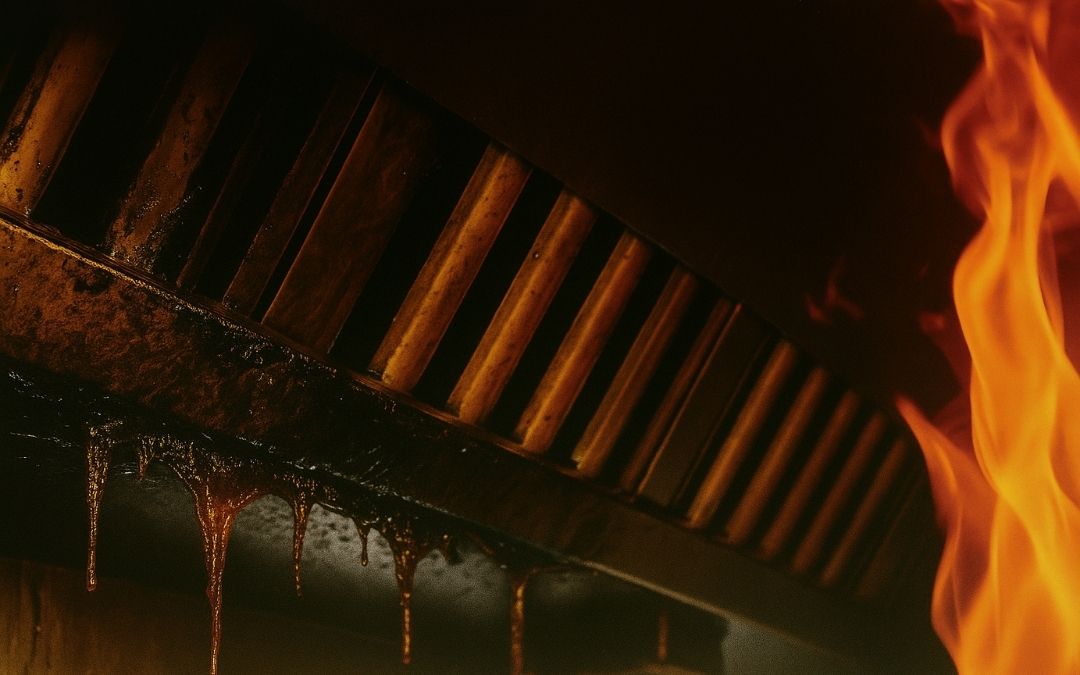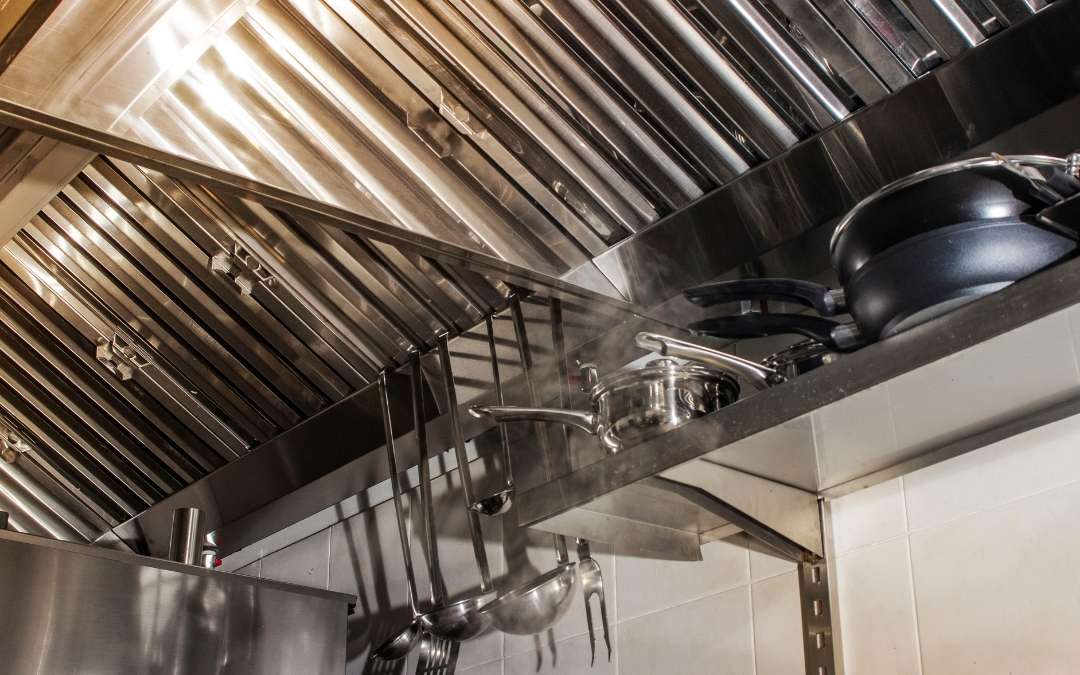Restaurant hood cleaning compliance is one of the most important yet often overlooked pillars of fire protection in commercial kitchens. Grease buildup in hoods, ducts, and exhaust systems is flammable and capable of turning a routine shift into a dangerous emergency within seconds.
However, when you stay compliant, every piece of your kitchen ventilation system is deemed to be working safely, reducing fire risk, meeting inspection standards, and keeping your operations running without costly interruptions.
In the following sections, we’ll discuss the standards, risks, and best practices every restaurant should know to keep commercial kitchens efficient and protected from fire.
How Grease Buildup Creates Fire Risk
Grease is an unavoidable byproduct of commercial cooking operations, and without proper control, it becomes a serious fire hazard. In any kitchen exhaust system, grease-laden vapors from cooking are pulled through the hood, exhaust fan, and ductwork, where they cool and condense on surfaces.
Over time, this buildup creates layers of flammable residue that are sometimes mixed with oily sludge, which can ignite with just a small spark or flare-up.
When suppression systems can’t do their job
Excessive grease accumulation increases the risk of fire as well as blocking grease removal devices and suppression nozzles, undermining the effectiveness of the very systems designed for fire prevention. A blocked nozzle can delay or prevent activation, giving flames time to spread through the kitchen hood and ductwork.
Compliance and professional cleaning
The NFPA 96 standard requires regular hood cleaning to remove combustible contaminants before they reach dangerous levels. Cleaning frequency depends on cooking volume: high volume cooking operations often require monthly service, moderate volume cooking operations quarterly, and low volume cooking operations semi-annually.
Even seasonal businesses, senior centers, and day camps must ensure systems are properly cleaned before reopening to maintain a safe environment.
Working with professional hood cleaning services or a certified company ensures the job is done to code. These experts are fully trained to reach all components that range from ducts and fans to other appurtenances of the exhaust system and provide detailed reports that satisfy fire marshals and insurance requirements.
With proper maintenance and regular cleaning, restaurants can keep ventilation systems at peak performance, protect their investment, and most importantly, keep people and property safe.
NFPA 96 Cleaning Standards
The NFPA 96 standard sets the industry benchmark for how often a kitchen exhaust system must be cleaned, and the requirements are based on the type and volume of cooking.
For high-volume or solid-fuel cooking (busy restaurants or facilities using wood-burning ovens, for example), cleaning is required monthly.
Moderate-volume operations are expected to schedule quarterly service, while low-volume cooking operations, e.g., smaller cafés, can typically follow a semi-annual schedule. For kitchens producing minimal grease, such as some institutional or seasonal setups, annual cleaning may be sufficient.
Adhering to these schedules keeps systems from becoming heavily contaminated with grease, which in turn reduces the risk of fire and avoids violations during inspections. Also, properly trained professionals will ensure every component from the hood to other appurtenances is thoroughly cleaned according to code, maintaining a clean and safe environment while protecting the business from costly downtime.
Regular, documented service will let you meet legal requirements but also support overall fire safety, effective fire prevention, and long-term system maintenance for your business.
Fire Protection in the Hood System

A restaurant’s hood and kitchen exhaust system often includes built-in suppression systems, typically wet-chemical units, designed to smother flames before they can spread. These systems depend on a clear, grease-free environment to operate effectively.
When grease buildup coats nozzles or clogs pathways, the suppressant may not discharge where it’s needed, which delays fire control and allows flames to escalate.
To ensure reliability, systems must undergo regular testing to confirm proper function and adherence to NFPA 96 and manufacturer specifications. Only approved components should be used for replacements or repairs; mixing brands or installing incompatible parts can void compliance and compromise system performance.
Partnering with properly trained professionals who follow code and manufacturer guidelines safeguards both fire safety and operational readiness in any commercial kitchen.
Why Professional Cleaning Is Crucial
If you run a commercial kitchen, you already know that a quick wipe-down at the end of a shift isn’t enough to keep your operation safe. True hood cleaning means getting into the hoods, ducts, exhaust fans, and every corner of your kitchen exhaust system, including the spots where grease and oily sludge hide and quietly build into a serious fire hazard.
Bringing in professional hood cleaning services gives you the peace of mind that the job is done right and up to NFPA 96 standards. A certified company will send properly trained technicians who know how to reach those problem areas, keep your grease removal devices working, and get your ventilation system back to peak performance. You’ll also get detailed reports and official certificates—proof you can hand to fire marshals or your insurance provider without worry.
In the end, you’re protecting your team, your customers, and the business you’ve worked hard to build.
Efficiency Gains from Clean Systems
A clean kitchen exhaust system lowers fire hazard risk and makes your whole operation run smoother. When hoods, ducts, and exhaust fans are free of grease buildup, airflow improves, pulling heat, smoke, and odors out of the kitchen more effectively. That means better air quality for your staff, steadier temperature control during the busiest shifts, and less strain on your HVAC system.
The result is a more comfortable work environment, faster-moving kitchen pace, and fewer equipment breakdowns. Over time, these benefits add up to real savings and a smoother day-to-day for your team, which helps you keep your focus on serving customers instead of fighting against an overworked ventilation system.
Practical Compliance Tips for Business Owners
Staying on top of restaurant hood cleaning compliance needs to be consistent. Start by keeping a clear log of your cleaning schedule so you always know when service is due. Track upcoming appointments so you can avoid lapses that could lead to grease buildup or inspection issues.
Always keep your before-and-after photos and official cleaning certificates in one place. These documents can be invaluable during health inspections, insurance audits, or when working with fire marshals.
Finally, try to coordinate hood cleaning with suppression system servicing. Doing both at the same time ensures your kitchen exhaust system is free of blockages and your fire protection equipment is in top working order.
Frequently Asked Questions
How often should a commercial kitchen exhaust system be cleaned for optimal fire safety?
The recommended frequency depends on your cooking volume and the type of operation. High-volume or solid-fuel cooking may require monthly cleaning, moderate-volume kitchens quarterly, and low-volume kitchens a different cadence. Minimal-grease environments might only need annual service. Follow your local laws, checking the requirements for your type of kitchen to keep grease buildup under control and help maintain fire safety.
Can a dirty exhaust fan increase the risk of a fire hazard in my kitchen?
Yes. A dirty exhaust fan can trap grease and oily residue. If a flare-up or spark reaches the fan, the buildup can ignite quickly and spread fire through the entire exhaust system. Regular cleaning removes these hazards and ensures proper airflow.
What role do professional cleaning services play in fire prevention for a commercial kitchen?
Professional cleaning services go beyond surface cleaning to remove grease from hoods, ducts, fans, and other exhaust components. They follow fire code standards, document their work, and provide certificates that inspectors require. This thorough approach greatly reduces the chance of a fire hazard and keeps your business compliant.
Why is maintaining an exhaust system essential for both fire safety and efficient kitchen operations?
A clean exhaust system improves ventilation, which reduces heat, smoke, and odors in the kitchen. Proper maintenance supports fire prevention, keeps equipment working efficiently, and helps ensure smooth day-to-day operations in any commercial kitchen.
Stay Safe, Stay Compliant, Stay Cooking
Every day you put your heart into running your business. Don’t let something as preventable as grease buildup put it all at risk. RAEL Fire Protection handles every detail of restaurant hood cleaning compliance so you can focus on your customers and not on code violations or fire hazards.
Let’s keep your kitchen safe, efficient, and ready for inspection year-round. Schedule your next cleaning with RAEL today and protect the business you’ve worked hard to build.
Ready to move beyond clean to compliant?
Keeping your kitchen exhaust system spotless is just one piece of the safety equation. To ensure your fire suppression system is code compliant and operational, download our “Semi‑Annual Commercial Kitchen Fire Suppression Inspection Checklist (NYC Edition)”. This guide helps New York-based restaurant operators understand what goes into a semi-annual inspection, how to prepare for it, and how to find the right vendor to do it.


Recent Comments